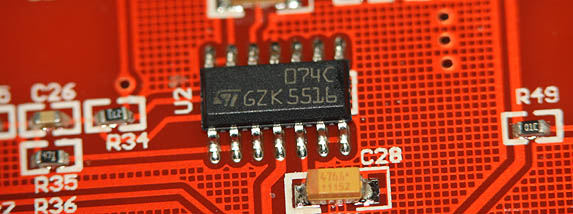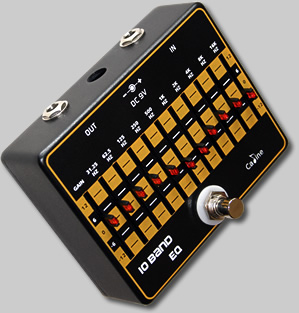Equalisation is one of those necessary evils of the audio industry which we are told should be avoided if possible, but which we will inevitably use all the same. The challenge is finding a good low noise Graphic EQ. |
GEAR RELATED ARTICLES
[Home Music Recording Studio]
GUITAR AMPLIFIERS:
Acoustic 450 - 170W Guitar / Bass Amp Head
Behringer Ultrabass BXL1800A 180W Bass Amp
Fender Princeton Chorus 51W Compact Amp
GUITARS:
Aspen AD25 6 String Acoustic Guitar
Esteve Model 8 Classical Guitar
La Patrie Concert CW QIT Classical Guitar
La Patrie Presentation Classical Guitar
Fender DG-14SCE Nat Acoustic Guitar
Godin XtSA Electric Guitar
Godin Freeway Classic Electric Guitar
Ibanez RG8 8 String Electric Guitar
Jim Beam Devil's Cut 335 clone
Maton EM125C - 6 String Acoustic Guitar
Maton EM425C/12 12 String Acoustic Guitar
Maton Mastersound MS500 - 6 Str Electric Guitar
Yamaha FG-410-12A 12 String Acoustic
Yamaha G-228 6 String Classical
GUITAR FX - The Chronicles of Zoom:
ZOOM GFX-707 - Review and Description
ZOOM 707 II - Review and Description
ZOOM BFX-708 - Bass Guitar Multi Effects Pedal
ZOOM G9.2tt - Guitar Effects Console
Behringer EM600 Echo Machine Stomp Box
Behringer RV600 Reverb Machine Stomp Box
ROLAND U-220 - Vintage Sound / Synth Module
SN-U110 and SN-MV30-S1 Series PCM Cards
Behringer FBQ1502HD Ultragraph Pro
Behringer Eurorack Pro RX1602 Rackmount Mixer
Capabilities of the CASIO WK-7500 Workstation
Presonus Eris E5 Powered Monitor Speakers
Vonyx (Skytec) SPJ-1000A Active 10" Speaker
[ Advertising ]
Overall Review Rating 4 / 10 - Avoid This!
At first glance I was actually impressed by the general build quality of the CP-24 single channel Graphic EQ. The graphics on the case are clear and 'useful' rather than showy. The weight of this device suggested straight up that they hadn't gone cheap on the box. Even the four retaining screws on the bottom are threaded (rather than the all too common self-tapping type). A great start ...
This unit needs to be powered by a
(negative centre) guitar effects 9V power supply. There is no battery compartment, suggesting the designers decided that the power consumption was never going to work with batteries. Given that each slider has its own red LED, I'm not surprised.
Graphic EQs with pretty lights: The idea of graphic EQ sliders that light up has been around for decades, and on a Graphic EQ stomp box, these LEDs can actually serve a useful purpose in many dimly lit places. On the domestic stereo Graphic EQs of old, they were mostly just annoying (often giving rise to Christmas tree jokes). At least the designers had the good sense to NOT use ultra-bright and ultra-annoying blue LEDs on the CP-24.
Power Specification Note: The current consumption for the device is not indicated on either the device or in provided PR literature and interestingly no manual is provided. On the web site the specified operating current is 30mA. Caline also makes several dedicated guitar effects power supply modules which have a standard output of 100mA (per output). One of these was used to power the CP-24. I have a feeling that this may be inadequate based on the CP-24's performance.
The CP-24's circuit board is a well designed and well manufactured SMD layout, so attempting user mods is not really advisable on this unit. You could quickly turn it into techno rubble with a single slip of the soldering iron.
The 10 EQ stages of the CP-24 are handled by Quad Op-Amp ICs. Which I can only say, is somewhat baffling, given that there are now dedicated Graphic EQ chips available to do exactly this job (and do it better).
SMD = Surface Mount Device Op-Amp = Operational Amplifier IC = Integrated Circuit
Op Amps in use are J-FET input
TL074c Quad Op Amps (074C -
GZK5516)

Given that this type of Graphic EQ design has been around since the first Op-Amp, I would suggest the functional arrangement of stages goes something like ... An input buffer, 10 EQ stages in parallel (each using a single Op-Amp), a summing amplifier (mixer) and an output buffer with gain. Some of the remaining Op-Amps may be employed as current regulation for the LEDs. Only one Op-Amp out of the 16 available appears to be un-used.
In this design the equalisation components for each band are included in the feed-back loop of an Op-Amp. This means the slider controls the Op-Amps gain (not volume) at the frequency determined by the accompanying components. The gain (and noise) of each stage is therefore added/mixed together (summed) at the output. This is the reason why these devices have always been notoriously noisy and readily prone to overloading and distortion.
A simple rule of thumb with this type of EQ is: The more stages, the greater the noise.
The distortion (just by the way) is often the result of boosting the lower frequencies (30Hz to 500Hz), which very quickly reduces the available head-room (Peak to Peak VRMS) in the summing / mixer amplifier. Since this device was designed from the outset to run from a power supply, it probably would have benefited from the use of a 12V supply with the output after the mixer attenuated as required to feed subsequent guitar effects/amps.
Sadly it appears that Caline have gone to a lot of trouble to resurrect a Graphic Equaliser design that was essentially always a nasty piece of work (noise wise) and which was technologically left behind
ago.
I can feel a project coming on here. Rebuilding this piece of electronic nonsense using the BA3822FS (5 band Stereo Graphic EQ) chip instead.
Using the CP-24:
The reason I got one of these (in a moment of sheer optimism), was to PreQ and boost the signal from a Strat copy, so that the tone and signal level were more in line with my main (Maton MS500) guitar. Thereby (hopefully) being able to use existing effects patches on the Zoom G9.2tt, rather than having to rebuild them just for the Strat copy ... Fail !
So with the cosmetics and construction aside, this is just another underwhelming multiband guitar graphic EQ. The standout results of using the CP-24 are:
- Like most other guitar Graphic EQs, the CP-24 gets noisy when the filter gain of any channel is pushed up (particularly frequencies at and above 2K Hz). The situation quickly worsens if multiple bands are boosted at the same time.
- Any reasonable amount of gain set on the gain control is likely to result in a distorted output regardless of the instrument in use.
- The device readily distorts with any reasonably powerful input.
Particularly like that from an acoustic guitar with pre-amped piezo pickup or even a high output humbucking pickup.
- Like many Graphic EQs, the CP-24 is best used in Cut mode rather than Boost. That is, keep the majority of your EQ curve below the 0dB line whenever possible.
- When all the LEDs are switched off the device is in Bypass mode.
All up, as far as this type of graphic EQ is concerned - situation normal (or perhaps SNAFU ![]() ;-)
;-)
Sadly that means that while the CP-24 device contains the components necessary to amplify/buffer/preQ a weak guitar signal (e.g. your standard Strat Copy), it won't really do the job. This makes the CP-24 about as useful as teets on a bull, and sadly, a complete waste of money. As a result you may notice the lack of a link to eBay on this page. I would not encourage anyone else to knowingly waste their money on this device.
In fairness, most multiband guitar Graphic EQs suck ... and ... are collectively responsible for most of the signal noise in the guitar pedal chains of the world. Beaten only perhaps by badly set up compressors and poorly shielded electric guitars (particularly those with single coil pickups). Also worth noting is that the Caline CP-24 is probably no worse than other Graphic EQs that cost twice as much. But it's still rubbish and I wouldn't use it even if it was free!
The provided product Description / Specifications:
|
Before I terminate this review, I should perhaps be a little more specific on the device's opperation.
There is supposed to be ±12dB of Boost/Cut per band and 12dB of gain available. From using the CP-24, I'm inclined to suspect those specifications are well and truly over rated.
The verdict on this device is simply 4 /10 - or - Don't Bother!
The pretty lights and excellent build quality don't compensate for miserable audio performance. And while it is at the low end (price-wise), that also won't make it any quieter or less annoying in practical use. If you really need a Graphic EQ, stay away from the Caline CP-24.
Incept Date: Wizard - 160806
Last Update: Wizard - 180818


